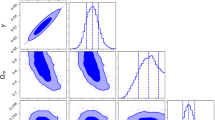Abstract
One of the principal goals of the quasar investigations is to study luminosity evolution. A convenient one-parameter model for luminosity says that the expected log luminosity, T*, increases linearly as θ 0· log(1 + Z*), and T*(θ 0) = T* − θ 0· log(1 + Z*) is independent of Z*, where Z* is the redshift of a quasar and θ 0 is the true value of evolution parameter. Due to experimental constraints, the distribution of T* is doubly truncated to an interval (U*, V*) depending on Z*, i.e., a quadruple (T*, Z*, U*, V*) is observable only when U* ≤ T* ≤ V*. Under the one-parameter model, T*(θ 0) is independent of (U*(θ 0), V*(θ 0)), where U*(θ 0) = U* − θ 0· log(1 + Z*) and V*(θ 0) = V* − θ 0· log(1 + Z*). Under this assumption, the nonparametric maximum likelihood estimate (NPMLE) of the hazard function of T*(θ 0) (denoted by ĥ) was developed by Efron and Petrosian (J Am Stat Assoc 94:824–834, 1999). In this note, we present an alternative derivation of ĥ. Besides, the NPMLE of distribution function of T*(θ 0), \({\hat F}\) , will be derived through an inverse-probability-weighted (IPW) approach. Based on Theorem 3.1 of Van der Laan (1996), we prove the consistency and asymptotic normality of the NPMLE \({\hat F}\) under certain condition. For testing the null hypothesis \({H_{\theta_0}: T^{\ast}(\theta_0) = T^{\ast}-\theta_0\cdot \log(1 + Z^{\ast})}\) is independent of Z*, (Efron and Petrosian in J Am Stat Assoc 94:824–834, 1999). proposed a truncated version of the Kendall’s tau statistic. However, when T* is exponential distributed, the testing procedure is futile. To circumvent this difficulty, a modified testing procedure is proposed. Simulations show that the proposed test works adequately for moderate sample size.
Similar content being viewed by others
References
Efron B., Petrosian V. (1999) Noparametric methods for doubly truncated data. Journal of the American Statistical Association 94: 824–834
Kaplan E.L., Meier P. (1958) Nonparametric estimation from incomplete observations. Journal of the American Statistical Association 53: 457–481
Kendall M.G. (1938) A new measure of rank correlation. Biometrika 30: 81–93
Lynden-Bell D. (1971) A method of allowing for known observational selection in small samples applied to 3CR quasars. Monograph National Royal Astronomical Society 155: 95–118
Neuhaus G. (1971) On weak convergence of stochastic process with multidimensional time parameter. The Annals of Mathematical Statistics 42: 1285–1295
Qin J., Wang M.-C. (2001) Semiparametric analysis of truncated data. Lifetime Data Analysis 7(3): 225–242
Robins, J. M. (1993). Information recovery and bias adjustment in proportional hazards regression analysis of randomized trials using surrogate markers. In Proceedings of the American statistical association- biopharmaceutical section, pp. 24–33. Alexaandria: ASA.
Robins J.M., Finkelstein D. (2000) Correcting for noncompliance and dependent censoring in an AIDS clinical trial with inverse probability of censoring weighted(IPCW) log-rank tests. Biometrice 56: 779–788
Satten G.A., Datta S. (2001) The Kaplan–Meier estimator as an inverse-probability-of-censoring weighted average. The American Statistician 55: 207–210
Shen P.-S. (2003) The product-limit estimate as an inverse-probability-weighted average. Communications in Statistics, Theory and Methods 32: 1119–1133
Tsai W.Y. (1990) Testing the assumption of independence of truncation time and failure time. Biometrika 77: 169–177
Turnbull B.W. (1976) The empirical distribution with arbitrarily grouped, censored and truncated data. Journal of the Royal Statistical Society, Series B 38: 290–295
Vander Laan M.J. (1996) Nonparametric estimation of the bivariate survival function with truncated data. Journal of Multivariate Analysis 58: 107–131
Vander Vaart A.W. (1995) Efficiency of the infinite dimensional M-estimators. Statistica Neerlandica 49: 9–30
van der Vaart A.W., Wellner J.A. (1996) Weak convergence and empirical processes with application to statistics. Springer, New York
Wang M.-C. (1987) Product-limit estimates: a generalized maximum likelihood study. Communications in Statistics, Theory and Methods 6: 3117–3132
Wang M.-C. (1989) A semiparametric model for randomly truncated data. Journal of the American Statistical Assocation 84: 742–748
Woodroofe M. (1985) Estimating a distribution function with truncated data. The Annals of Statistics 13: 163–177
Author information
Authors and Affiliations
Corresponding author
About this article
Cite this article
Shen, Ps. Nonparametric analysis of doubly truncated data. Ann Inst Stat Math 62, 835–853 (2010). https://doi.org/10.1007/s10463-008-0192-2
Received:
Revised:
Published:
Issue Date:
DOI: https://doi.org/10.1007/s10463-008-0192-2




